Some posts on this site contain affiliate links. If you book or buy something through these links, I earn a small commission (at no extra cost to you). Take a look at my privacy policy for more information.
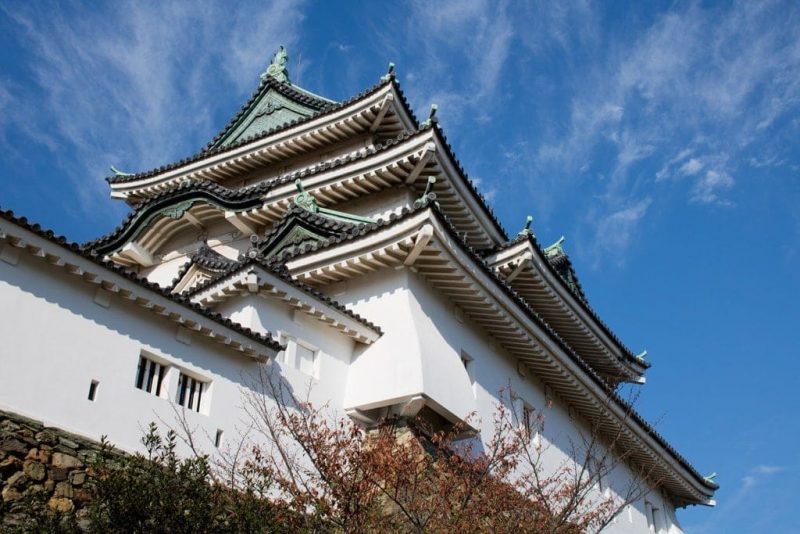
An in-depth travel guide for Wakayama City – a fantastic hidden gem on Japan’s south coast…
When people think of Japan, they tend to think of the major cities. The temples of mystical Kyoto, the food of Osaka, or the craziness of Tokyo.
But, as with all countries, there’s so much more to Japan than the big cities and major tourist sites. Recently, I headed to Wakayama City to discover a bit of Japan off the beaten path – and that’s exactly what I found!
Despite being just an hour from Osaka by train, Wakayama City is completely off the radars of most Western tourists. During my trip, I was the only white tourist I saw; in fact, I seemed to be one of the only tourists around!
But travel in Wakayama City is just as easy as the rest of Japan, and this is a stunning city with a wealth of history and culture to discover.
Below is my mini Wakayama City travel guide to help you discover this beautiful, serene coastal city. This is a guide to spending two or three days in the city and exploring its main attractions. Enjoy…
My visit was part of a press trip organised by Tashizan on behalf of Wakayama City. As always, all views and opinions are entirely my own and without bias.
Why Visit Wakayama City?
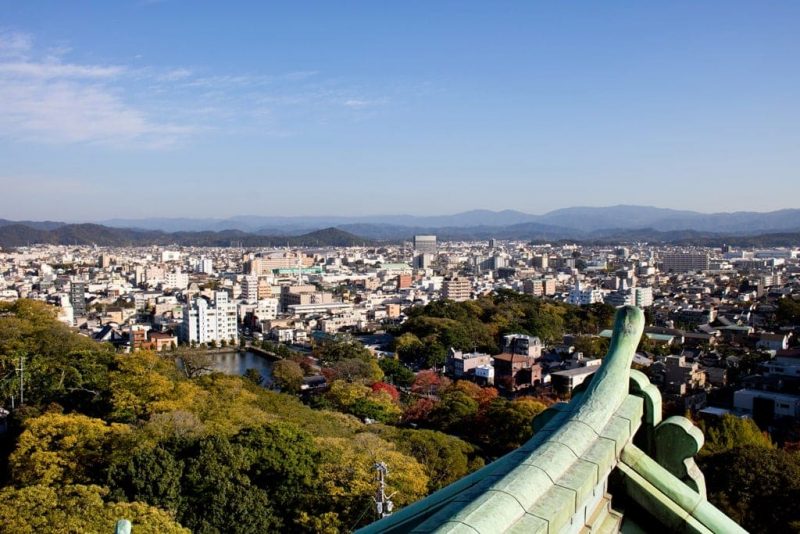
If you want to get a little off the beaten path in Japan, Wakayama City could be perfect for you.
A coastal city with some great beaches and plenty of stunning nature nearby, it’s hugely popular with Japanese tourists, especially in summer. But it’s still relatively undiscovered by Western tourists – which, for me, is the biggest attraction.
Wakayama is a peaceful little city, but there’s plenty to attract tourists. With unique cuisine (including ramen voted the best in Japan), a faux-Meditarranean port, dozens of shrines, natural hot springs, and plenty of green spaces… there’s a lot on offer here.
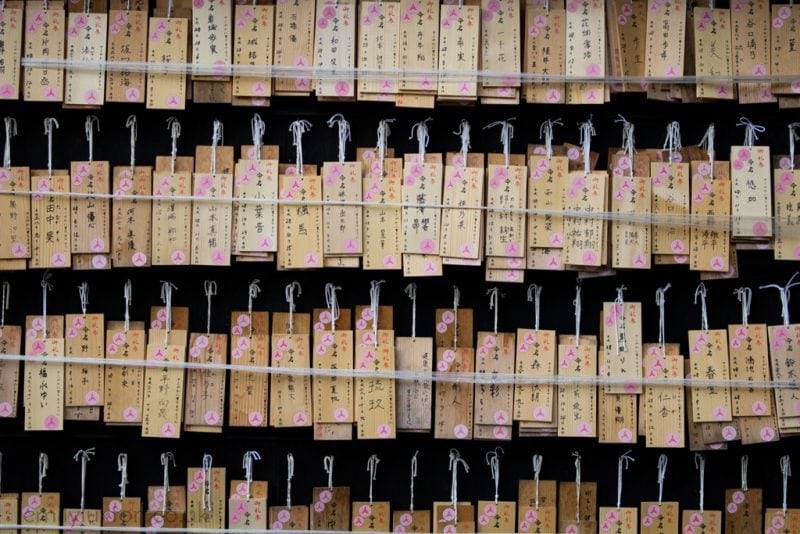
While I’m sure the city, and in particular the beaches, are amazing in summer, for me, autumn was the perfect time to visit. Attractions were quiet, and the gold and red autumn leaves in the parks and natural spaces created the most beautiful backdrop.
My Wakayama City guide is packed with my own top tips and personal recommendations. I did and saw everything mentioned below (with a couple of exceptions) in a three-day, two-night trip. As you can see, it’s possible to do a lot in Wakayama City in a short time. But if you want to relax more, stay longer and take things slower than I did.
Getting There
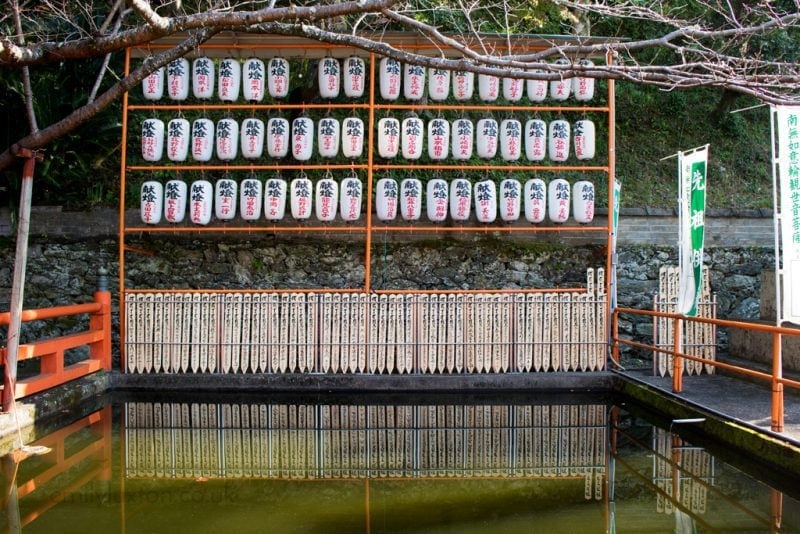
Arriving By Air
If you’re flying into Kansai International Airport (KIX) in Osaka, you can take a direct bus (Limousine Bus, ¥1,150) to Wakayama Station. It takes just 40 minutes, non-stop. Alternatively, you can take the JR Line train for ¥890: take the JR Kansaikuko Line to Hineno Station and change here for the JR Hanwa Line to Wakayama Station. The whole journey should take around 50 minutes. Changing trains at Hineno is very easy; all signs are translated into English, and in my experience, station staff throughout Japan were fantastically helpful.
Note: there are two central train stations in Wakayama City; Wakayama Station and Wakayamashi Station. Check which one is closest to your hotel to make your journey easier.
From Osaka
Head to Namba Station and take either the Nankai Limited Express (1 hour, ¥1,430), or the Nankai Line (1 hour 10 minutes, ¥920) to Wakayamashi Station. Alternatively, from Tennoji Sation you can take the JR Hanwa Line (1 hour 12 minutes, ¥860) to Wakayama Station.
From Tokyo
The Shinkansen (bullet train) from Tokyo Station to Shin-Osaka Station takes 2 hours 30 minutes and costs ¥14,250. From there, follow the route above to reach Wakayama City.
Getting Around
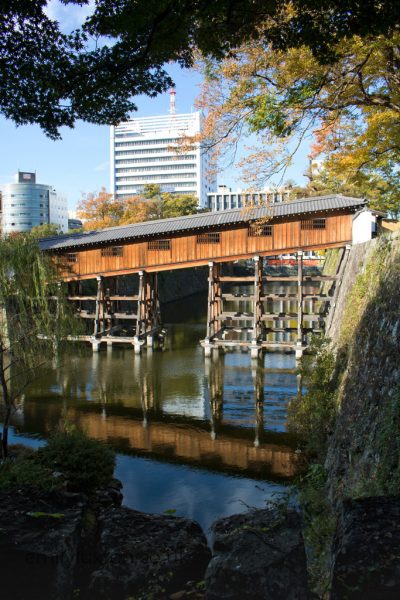
The public transport in Wakayama City, like most of Japan, is exceptionally easy to navigate. There are frequent local trains that will take you to various points in the city or further afield in the province. Signs are generally translated into English, and at most stations, there are plenty of staff on hand to offer help if you need it.
Google Maps is extremely accurate and up to date throughout JApan, and even shows the journey prices, which is handy. However, when I visited, Google Maps didn’t have any bus information so I found the busses in Wakayama City harder to use. You can pick up a bus route map from your hotel which should help.
Much of Wakayama City is extremely walkable. Streets are mostly in a grid formation, and despite being a large city, the centre is fairly compact. It’s very easy to get around by walking and this is a great way to see as much of the city as possible. I’d also recommend renting a bike so you can explore easily. The roads are quiet and very safe, so this is a great way to get further afield.
Taxis are available and can be flagged down easily, but they tend to be quite expensive – and since public transport is so easy, I wouldn’t recommend taking a taxi unless you need to.
Top Things to do in Wakayama City
1. Wakayama Castle
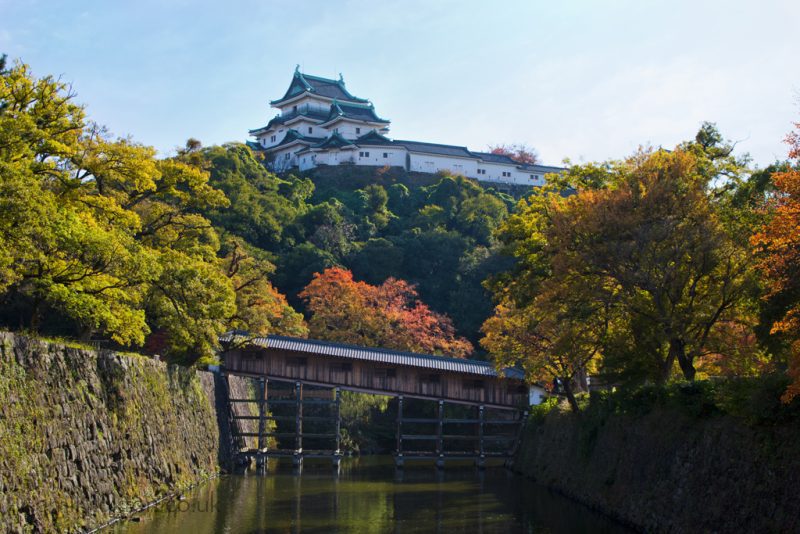
The main attraction in Wakayama is the bright white castle which towers over the city centre. Perched on top of Mt. Torafusu, Wakayama Castle originally dates from the Tensho Period (1500s) and it’s ranked among the top 100 castles to visit in Japan.
Inside the castle is an interesting museum, and some amazing views of the city. But the real highlights for me were the castle grounds, which are stunning, and the architecture of the castle itself.
Entrance fee: ¥400
2. Wakayama Park
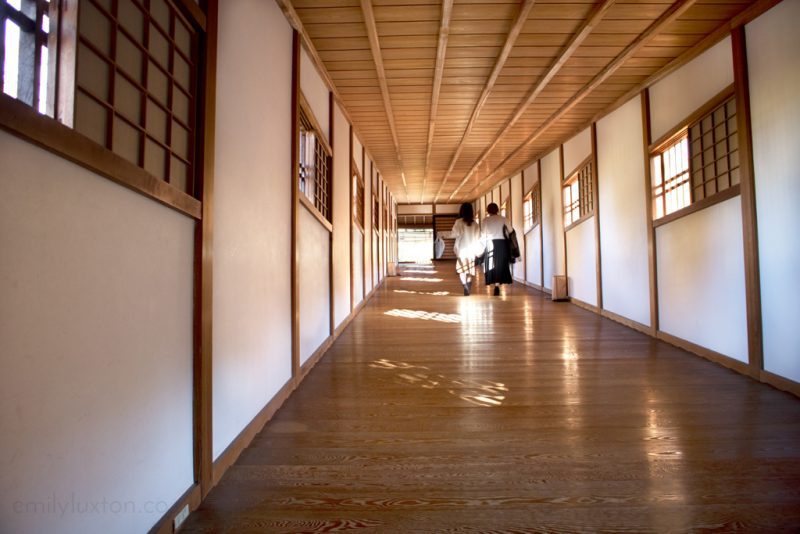
The grounds surrounding Wakayama Castle have become a beautiful, free-to-enter park. It would be easy to spend an hour or two exploring the park and the castle, especially if the weather’s nice, which is exactly what I did.
Highlights include the gorgeous Ohashi Roka (a 27-meter-long, slanted, covered bridge), the 17th Century Okaguchi-mon Gate, and the Koshoan Tea Room (¥460 for a cup of matcha tea).
No entrance fee
3. Momijidani Gardens
Also in Wakayama Park are the beautiful Momijidani Gardens, overlooking the Ohashi Roka bridge. This is a beautiful natural space, set around a man-made moat and designed to create a feeling of zen within visitors. I’d say it works!
No entrance fee
4. Marina City and Porto Europa
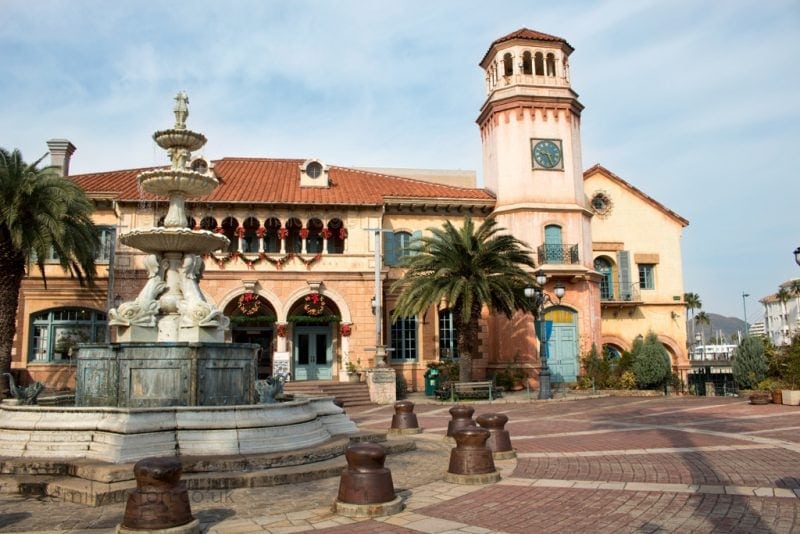
In the southernmost part of Wakayama City lies the artificial island of Marina City. This is a real tourist hotspot, home to the yacht harbour and a huge resort hotel.
I got a real kick out of the small theme park Porto Europa, which has been designed to look like the streets of port towns in Mediterranean Europe. The Disney-esque, Japanese take on France and Spain is pretty interesting to see – plus there are street performers, shows, and rides. It’s not the most traditional experience, but it’s good fun just the same!
No entrance fee. A pass for the Porto Europa rides costs ¥2,700. Read more.
5. Kuroshio Market
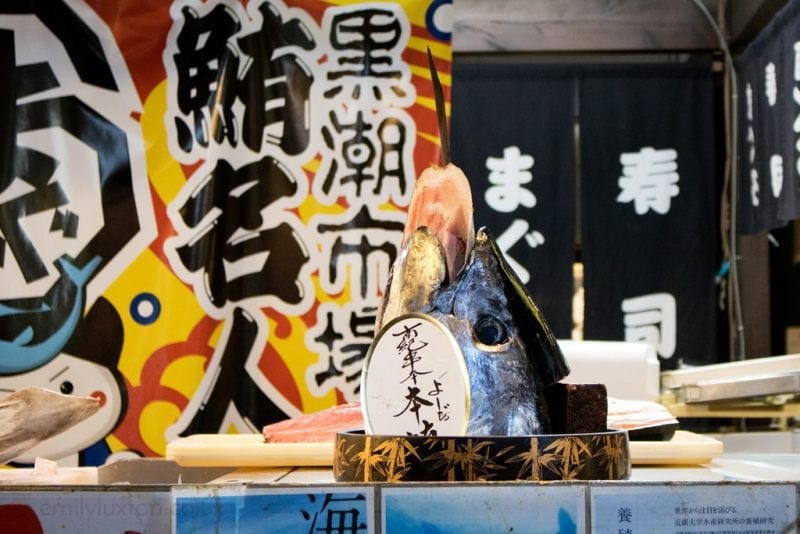
One of my favourite spots in Wakayama City was Kuroshio market, Wakayama’s fish and seafood market. It’s just outside Porto Europa, and features all kinds of incredible fresh seafood, from sushi to tempura to barbecue. Bring your appetite – and plenty of money! The real highlight here is the free live tuna filleting show, which takes place three times a day – don’t miss it.
No entrance fee
6. Wakanoura Bay
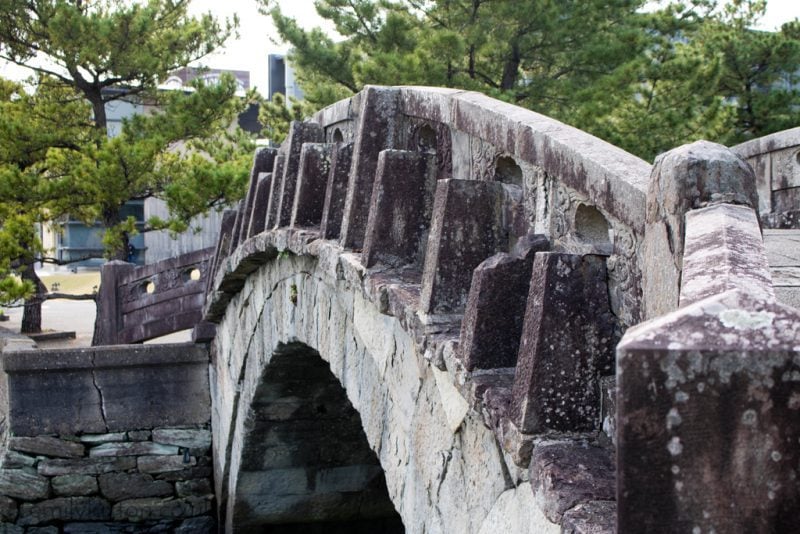
Waka-no-ura, meaning Poem Bay, has been mentioned for its scenic beauty by numerous Japanese poets. The surrounding town of Wakaura is known for its trendy coffee shops, and bakeries like Shuneido chock-full of cream puffs and other goodies. This is a great place to discover on foot or by bike, so grab a map and explore – the top sights here are:
- Furobashi Bridge, a beautiful arched stone bridge built in the 1850s.
- Tamatsushima-jinja Shrine – don’t miss the beautiful views from the hill behind.
- Shiogama Shrine – set within a small cave in the cliff.
- Kankaikaku – a tine sharing shrine on the hilled islet of Inose-yama.
No entrance fee
7. Meet the Stationmaster Cat
Kishi Train Station is probably the only station in the world to have a cat as it’s stationmaster. When Tama, the calico cat, was appointed stationmaster, she instantly put this tiny train station on the map. After she died in 2015, her apprentice Nitama took on the important job. Only in Japan!
To get there, take the Kishigawa Line from Wakayama Station to Kishi. A one-day pass costs ¥720 per adult (child ¥360) and allows visitors to hop on and off the train as much as they like. Perfect for visiting the various shrines and attractions along the 30-minute route.
No entrance fee
Wakayama City Shrines and Temples
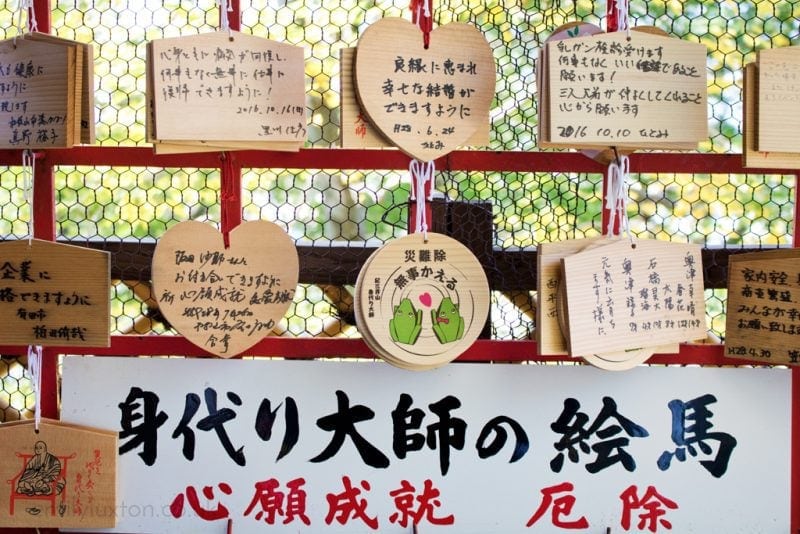
With so many Buddhist shrines and temples, you could spend days in Wakayama City and still not discover them all! Below are just a handful of temples and shrines I’d recommend visiting, but there are hundreds more…
Kimiidera Temple
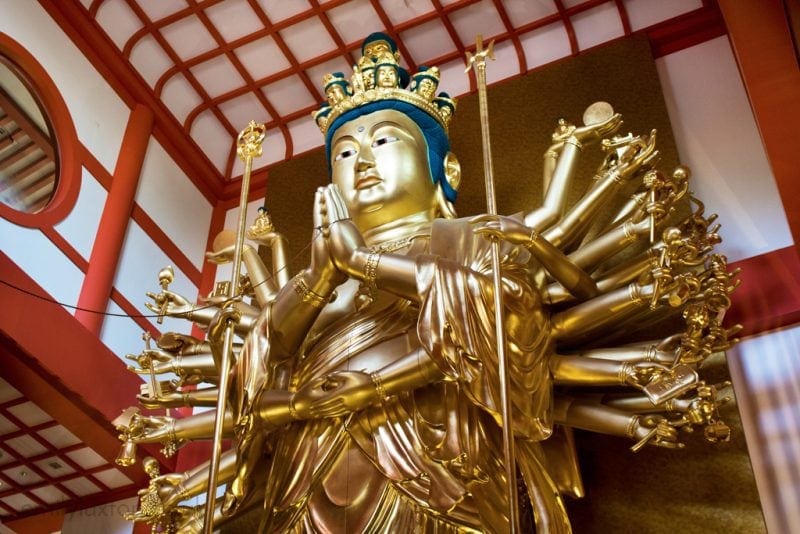
Founded roughly 1250 years ago, Kimiidera temple stands on the edge of Mt Nagusa-yama and has amazing views of the city. I fell in love with the serenity and peace at this leafy temple complex; it’s beautiful!
This is the second temple along the oldest pilgrimage route in Japan. Kimiidera is also home to a huge gold-coloured Buddha statue known as Senjyu Kannon; at 12m tall it’s the largest wooden statue in the country.
Entrance fee: ¥200. To get there take a train from Wakayama Station to Kimidera: it costs ¥190 and takes 7 minutes.
Tamatsushima-jinja Shrine
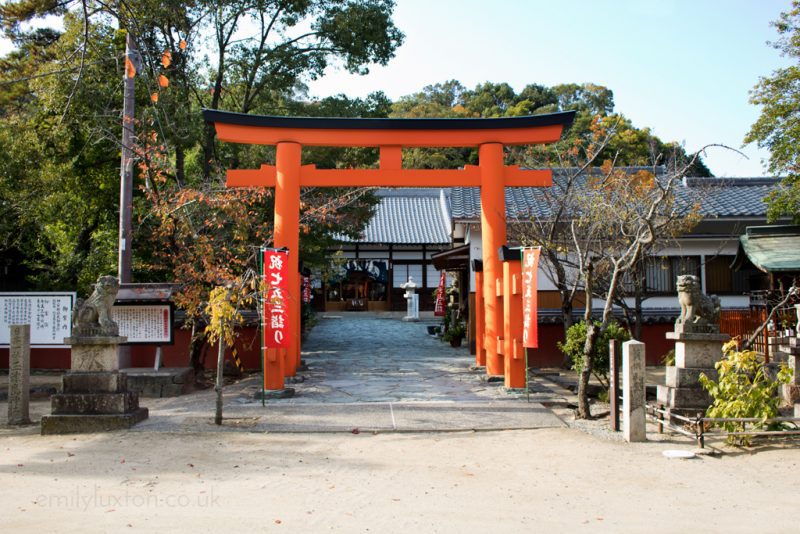
Another ancient temple, Tamatsushima-jinja Shrine in Wakanoura has been popular with Japanese poets for centuries and appears in many works. Don’t miss the climb to the top of Mt. Kagamiyama behind the shrine – it only takes a couple of minutes and there are great views from the top.
No entrance fee.
Wakayama Park Shrine Walk
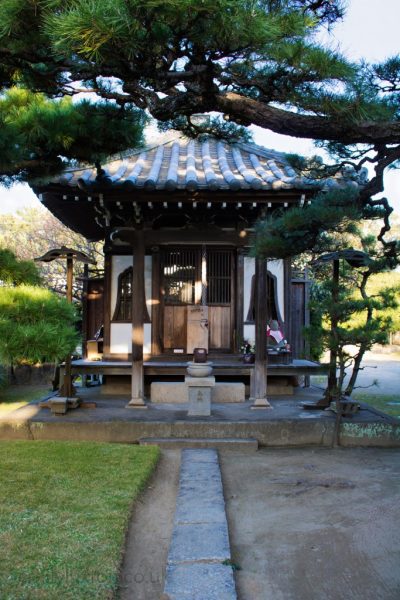
If you’re short on time, there’s a great walk that takes in a handful of shrines and other attractions close to Wakayama Castle. Starting at the Okaguchi-mon Gate in the southwest corner of the park, head south through Oka-koen Park to Sasutahiko-jinja Shrine.
Two blocks down, take a right at the main road and head to Muryokoji Temple – also nearby are dozens more temples, so swing by these if you have time. Then head back up towards the castle by way of Hoonji Temple and the Okayama-no-jishodo Bell Tower.
No entrance fees.
What to Eat in Wakayama City
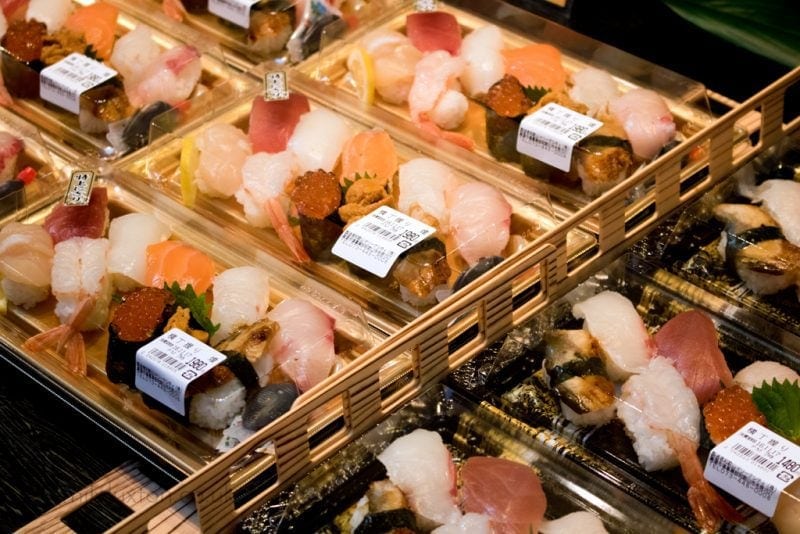
Seafood
Being a coastal town, Wakayama City is famous for its seafood. Head to the Kuroshio fish market to see a live tuna filleting demonstration – and to sample the best local seafood to your heart’s content. Sushi, sashimi, tempura, barbecue… this place pretty much has everything you could possibly want!
For the freshest of the fresh, go for the locally-caught specialities. Look for sea bream, red snapper, shirasu (young sardine), ashiaka ebi (red-legged shrimp), hamo (pike conger eel), Wakayama seaweed, and nori seaweed.
Wakayama Ramen
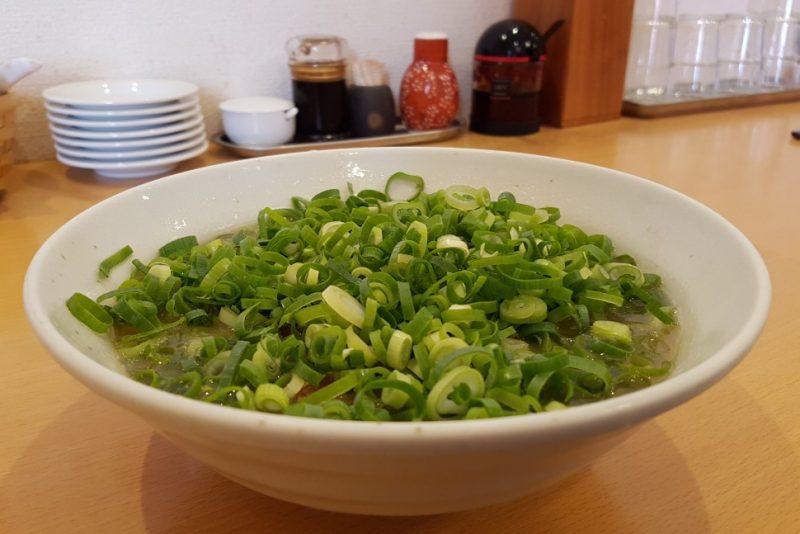
While ramen is popular all over the country, Wakayama’s take on the dish is very different – and is considered by many to be the best ramen in Japan. Known locally as Chuka-soba, the dish is simple, but the main difference is the broth used. Wakayama Ramen is made with a pork-bone soy sauce broth which is far richer than normal ramen dishes.
The most famous restaurant is Ide Shoten, so if you only have time to visit one restaurant, make it this one. It was voted Japan’s “most delicious” ramen, and there’s usually a long line of locals.
I also recommend Ramen Marui (the Junibancho branch), where the ramen comes smothered in spring onions. It’s thick, rich, and totally delicious!
Other foods you shouldn’t miss:
- Green Tea Ice Cream
- Cream Puffs from Shuneido
- Umeboshi (salty pickled plums)
- Tangerines
- Wakaura Senbie (egg crackers embossed with scenes from Wakaura)
- Ginger and Ginger Ale. Wakayama is known for its production of raw ginger, so don’t miss this key local ingredient.
Wakayama City Onsens
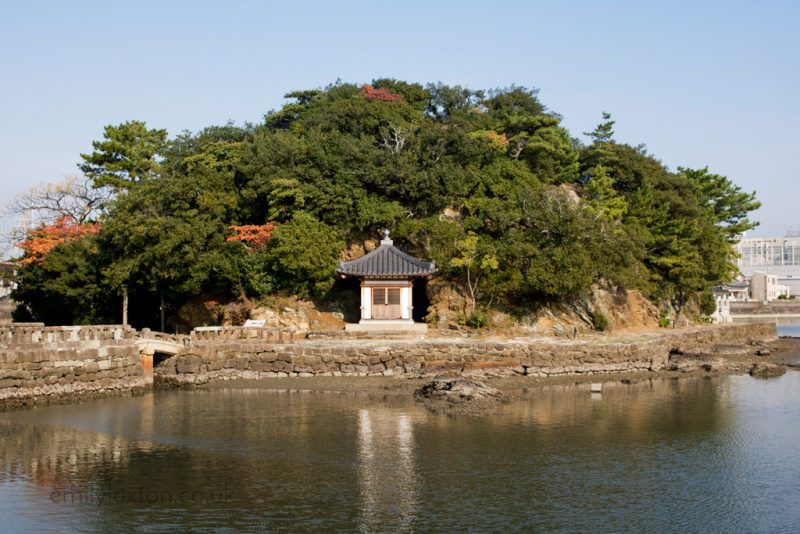
If you want to try the Japanese tradition of hot spring baths, called onsens, Wakayama City is a great place to do it. The city is famous for its ancient natural hot springs. Many hotels, even in the city centre, feature onsens – but the actual hot spring resorts tend to offer a richer experience.
Wakayama’s onsens are rich in minerals like hydrogen carbonate or chloride, thanks to the city’s proximity to the ocean, and are said to be great for muscle pain, neuralgia, and dermatitis.
I headed to the onsen at Kiyukamura Kishu -Kada Hotel in the national park near Kada, and absolutely loved it. Outdoor baths with an ocean view, overlooking the Tomogashima Islands… it was heaven. The main attraction at this onsen is the Bihada Hot Spring, where the water is cloudy and slightly viscous because it’s packed full of natural minerals!
How to get there: take a train to Kada station. From the station car park, there are regular free shuttle buses to the resort.
Beaches in Wakayama City
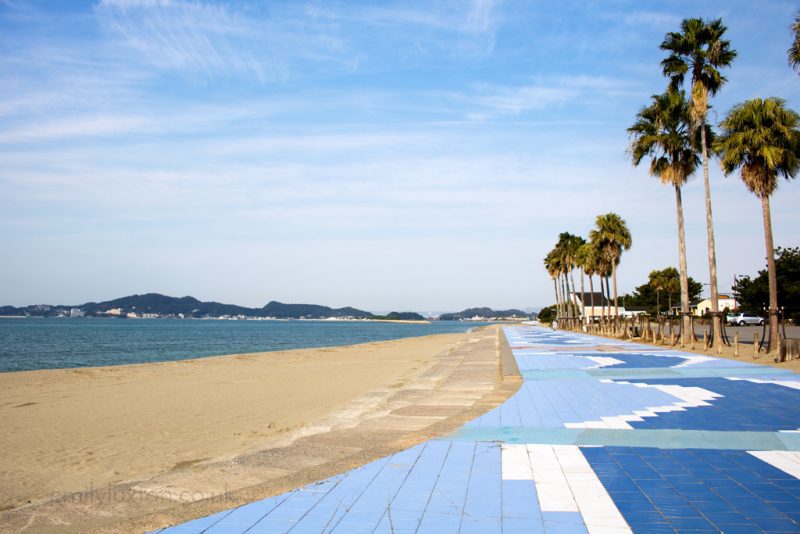
Perched on the coast, Wakayama City has a number of beautiful beaches to discover. In summer, these are incredibly popular with locals.
Even in autumn, the beaches are lovely areas to go for a stroll. I loved walking along the blue-tiled boardwalk at Hama no Miya Beach, not far from Marina City. A nice, clean beach and some lovely views – what more could you ask for?
Read More: If you’re headed to Wakayama City during summer, check out the full list of beaches here to get some ideas.
Where to Stay
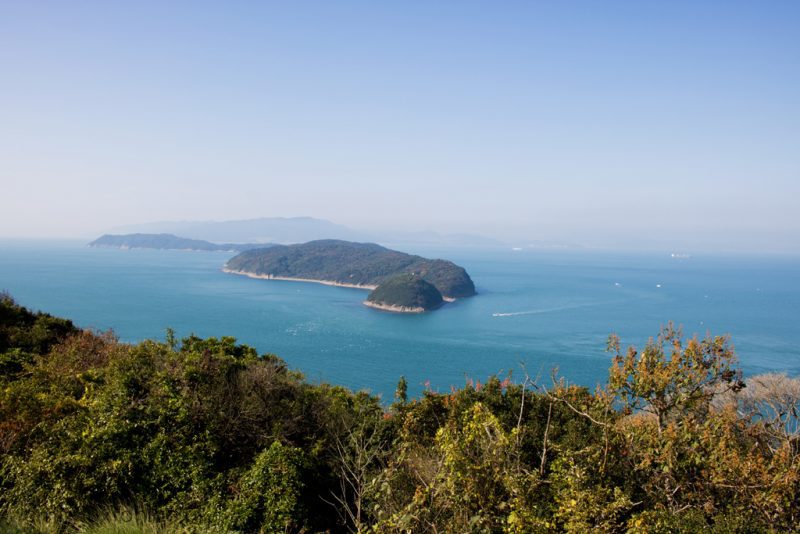
There are plenty of excellent accommodation options to suit all budgets and tastes. These range from simple guesthouses and dormitories to classic hotels – as well as some gorgeous hot spring resorts.
In Wakayama City, there seemed to be four main styles of accommodation:
Guest houses and hostels: Such as Guesthouse Rico (dorms from £22 per night) features both dorms and budget private rooms.
Business Hotels: I stayed one night at the Dormy Inn Premium (from £47 per night). Rooms were small, but well furnished and comfortable – and they serve a free bowl of noodles to guests every evening at around 9pm. There’s a small onsen in the hotel, and the service is wonderful. I’d happily recommend this hotel for anyone looking for somewhere quiet and comfortable to stay in Wakayama City centre.
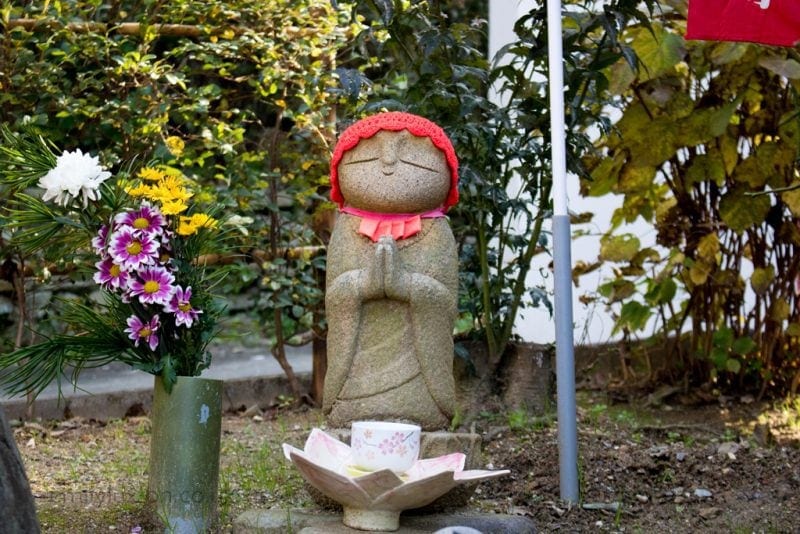
Hot Spring Resorts: Like Kyukamura Kishu-Kada (from £87 per night), where I spent my second night in Wakayama City. The onsen here is incredible – and the resort is surrounded by a stunning national park. This is the perfect place for some rest and relaxation in total peace and quiet. Plus, the food in the resort’s restaurant is gorgeous – the best sushi I’ve ever had!
Beach Resorts: Close to the beaches, you’ll find large resort hotels like the incredible Wakayama Marina City Hotel (from £73 per night).
Visiting as a Solo Female Traveller
I was travelling solo in Japan, so I was a bit wary of heading a little off the normal “tourist trail” to visit a place like Wakayama City. However, I can confirm that the city (and indeed the rest of Japan) is ideal for solo female travellers.
Wakayama City is easy to get around and I found most locals I met were super friendly and helpful. People were always happy to help a confused-looking tourist in train stations and on public transport: I’ll be forever grateful to the station guard who not only helped me find my train, but also insisted on helping with my luggage all the way to my seat!
There aren’t many dormitory-style hostels in the city (guesthouses are more common), but there are a few capsule hotels which can be a great alternative (THE S3 Wakayama Station looks fab). You could always join some group tours if you want to meet fellow travellers.
READ MORE: My Solo Female Travel Tips
Wakayama City Travel Guide: Map and Quick Version
Things to do: The Quick List
- Wakayama Castle
- Wakayama Park
- Momijidani Gardens
- Marina City and Porto Europa
- Kuroshio Market
- Wakanoura Bay
- Meet the Stationmaster Cat
- Kimiidera Temple
- Tamatsushima-jinja Shrine
- Wakayama Park Shrine Walk
- Hama no Miya Beach and other beaches
- Visit an Onsen – or stay at an onsen resort
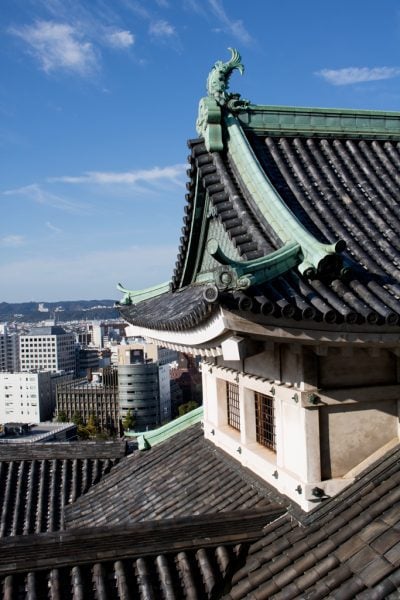
If you’ve been to Wakayama City and have a great tip or recommendation to share, scroll down to leave a comment and help your fellow travellers. Likewise, if you have a question feel free to ask in the comments or on socials (I’m @em_luxton) and I’ll do my best to help out!
READ MORE: 17 awesome places to get off the beaten path in Japan
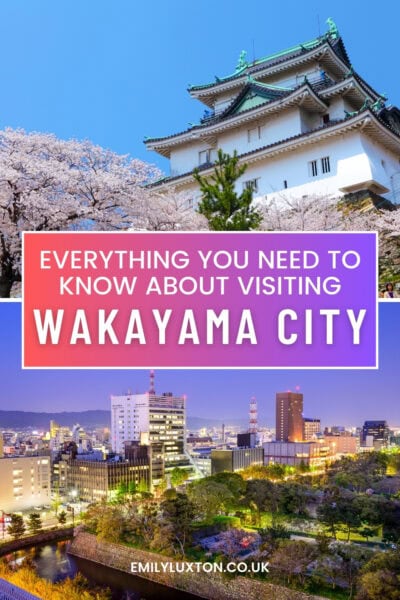

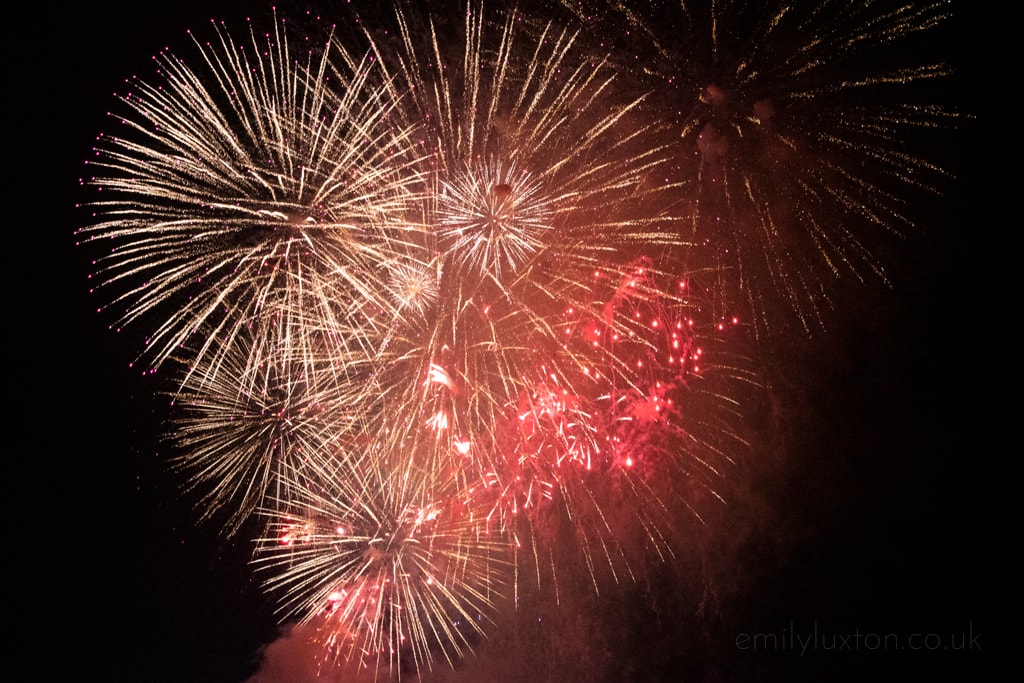
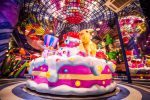
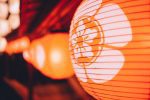
Have you heard of the Kumano Kodo Pilgrimage in Wakayama? It’s sister to the Camino de Santiago and a really beautiful experience. http://wp.me/p5wywo-ox
Funnily enough I have heard of it – I was in Wakayama City last year and heard about it while I was there. So cool that you’ve actually done it. The nature around that area is gorgeous :)
I may get the chance to go to Wakayama in September and your guide really helped to get a feeling for the city! Thanks!
Oh wow really?!! That’s so exciting! September is a great time to visit Japan too, I was there in October and the weather was lovely. Wakayama is so awesome I hope you do get to go :)
I’m going in September too. Your blog made me decide to must go to wakayama. Thank you for sharing
YAY that’s awesome to hear!! Enjoy your Japan trip – I hope you have a great time in Wakayama :)
I wanted to travel to Tokushima by ferry is that possible, and make my way over to
Onomichi to visit the chapel
Hi Paul!! I’m really sorry – I’m not sure if it’s possible. I didn’t have a chance to visit Tokushima so I’m not sure about the ferries. I think Japan has amazingly accurate info on Google maps though so try doing a search on there and see what the times are like!
Hi Emily,
I’m thinking to stay my first night in Wakayama City the end of november of this year. My airplane arrive at 9:00 AM to Kansai, so I hope to see Marina City, Castle and the park the same day. Do you think its possible?
Ty, great blog !!
Hi! I think it’s definitely possible. It’s about an hour from Kansai to Wakayama City, so once you’re through customs, pick up your bags, and take the train, it might be nearly 11 by the time you’re in Wakayama. That should give you an hour or two for the castle and the park, which are in the same place and close to the city centre. And then you have the rest of the afternoon for Marina City!
Hope that helps. Have an amazing trip :)
It’s probably too late, but here you have the schedule for ferry http://tomogashimakisen.com/jikoku.html.
Ah thanks so much for this Ina. Even if it is too late you might be able to help another traveller :)
I wanted to experience it but i am an unfit solo traveller. Sounds too challenging.
What sounds too challenging? Wakayama is just a city – you don’t need to be fit to travel there! I’m definitely not fit – I never exercise haha!
I am having 5 days free after a conference in osaka. I plan to spend 2 nights at Minoh to enjoy the parks and then head south to wakayama. Should I spend the nights at different locations or would it be better to be based from the city? You spend 2 nights at different places. I am worried about carrying big bags.
Hi Anne! For the most part of my trip, I stayed in the city centre – it was very easy to get around to other places by public transport and there are lots of trains etc. I spent one night at the ryokan at the end of my trip in order to enjoy the hotsprings and try the whole ryokan experience. If you’re interested to do that, then I recommend splitting your stay as I did and spending a night at one of the ryokans outside of the city. But it would be just as easy to base yourself in the city centre the whole time and use the trains/buses/Uber etc to explore the area. Hope you enjoy your time in Japan :)
I really want to go here if and when I visit Japan. I want to take both my bf and son as their last name is Wakayama! I just think it would be such a cool experience for all of us. I’m bookmarking your blog for when we decide to travel there, so thank you for this!
Oh that is cool!! I’m sure you could find some street signs to take fun photos with there next to their last name!! Hope you make it there soon, Japan in general is a wonderful country and Wakayama was a really cool city!
Ide Shoten restaurant requires reservations?
Thank you for all your great info! We are doing a 3 week trip and already had this city on our list but your article was very informative!
Thanks so much Katie!
I don’t think you can make a reservation there, it’s quite a casual restaurant and usually has a long line. I think it’s just a “turn up and wait” kind of place. Hope you have the BEST trip!